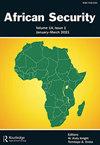Performing Shīʿīsm and Martyrdom: The Place of Religious Songs in the #freeZakzaky Occupy Abuja Movement
IF 1.3
Q2 POLITICAL SCIENCE
引用次数: 0
Abstract
ABSTRACT This study examines the transformation of IMN’s religious songs associated with IMN’s religious rituals as a means of framing martyrdom in the face of state suppression; protesting against the secularity of the Nigerian State, and calling for the release of IMN’s leader Sheikh Ibrahim al-Zakzaky during the #FreeZakzaky Occupy Abuja Movement. Why does the IMN incorporate its religious songs into street protests and what roles does it play in performing pain, suffering, and martyrdom in the occupy movement? This study is framed around the theoretical conceptualization of “radicalism” to understand the causes of the IMN’s radical approaches in ideologies, its frequent confrontational protests against the State security apparatus, and the implication for future religious radicalization. The causes of the IMN protests are performed through songs to narrate the Zaria carnage and the State’s violence against the IMN and reenact the religious ideation of martyrdom. The immortalization of martyrs and the religious ideation of achieving martyrdom became a collective identity of performing suffering and death as a religious necessity for IMN’s true followers amid religious repression during the #FreeZakzaky Occupy Abuja Movement. I argue that the performance of the pain and suffering of past and present events will further radicalize members of the IMN, and in the future, there could be a possibility of some of them integrating into a violent jihadi group as a means of self-defense and religious determination against the predominantly Sunni community, and by extension, the Nigerian State.表演Shīʿīsm和殉道:宗教歌曲在#freeZakzaky占领阿布贾运动中的地位
摘要本研究考察了IMN宗教歌曲的转变与IMN的宗教仪式,作为在国家镇压下塑造殉难的一种手段;抗议尼日利亚国家的世俗化,并在#FreeZakzaky占领阿布贾运动期间呼吁释放IMN领导人谢赫·易卜拉欣·扎克扎基。为什么IMN将其宗教歌曲融入街头抗议活动,以及它在占领运动中扮演了什么角色来表现痛苦、苦难和殉难?本研究围绕“激进主义”的理论概念展开,以了解IMN在意识形态上采取激进做法的原因、其对国家安全机构的频繁对抗性抗议,以及对未来宗教激进主义的影响。IMN抗议活动的起因是通过歌曲讲述扎里亚大屠杀和国家对IMN的暴力行为,并再现殉难的宗教思想。在#FreeZakzaky占领阿布贾运动期间的宗教镇压中,殉道者的不朽和实现殉道的宗教思想成为了IMN真正追随者的一种集体身份,将痛苦和死亡视为宗教必需品。我认为,过去和现在事件的痛苦和折磨的表现将进一步激进化IMN成员,在未来,他们中的一些人可能会融入暴力圣战组织,作为自卫和宗教决心的手段,对抗以逊尼派为主的社区,进而对抗尼日利亚国家。
本文章由计算机程序翻译,如有差异,请以英文原文为准。
求助全文
约1分钟内获得全文
求助全文

 求助内容:
求助内容: 应助结果提醒方式:
应助结果提醒方式:


